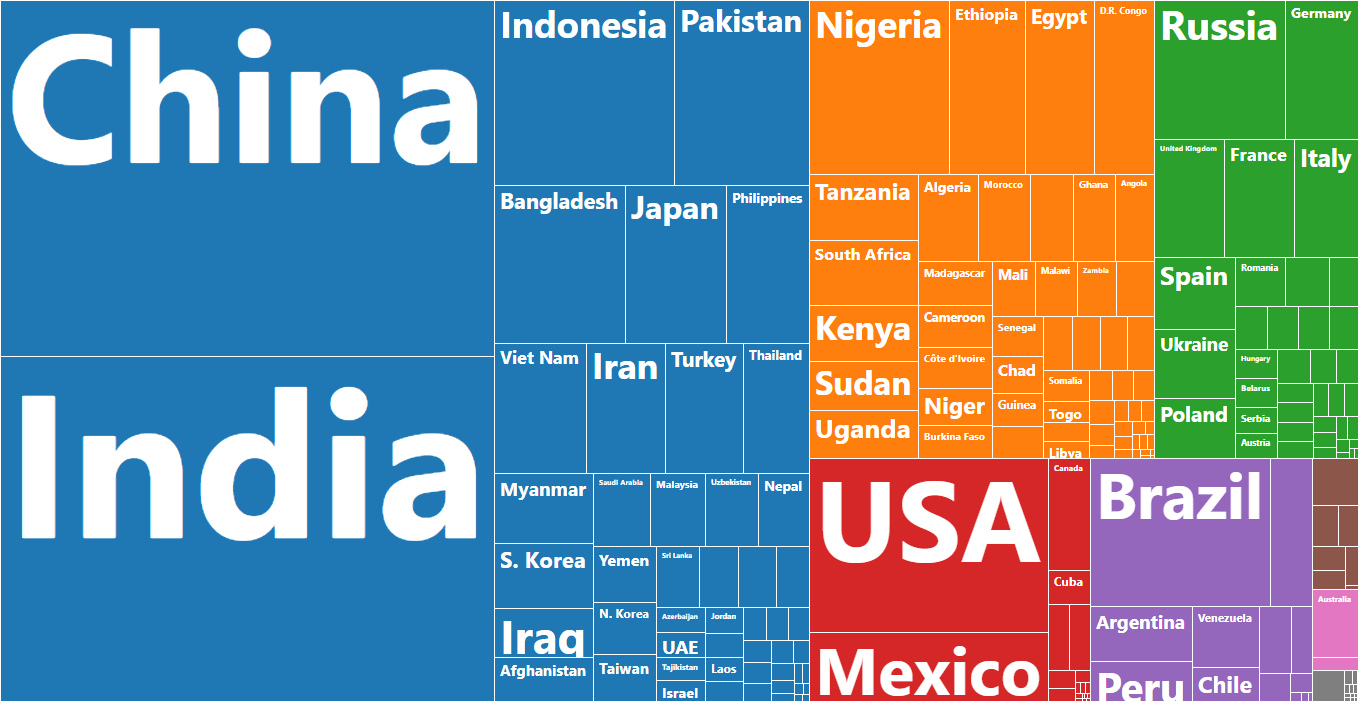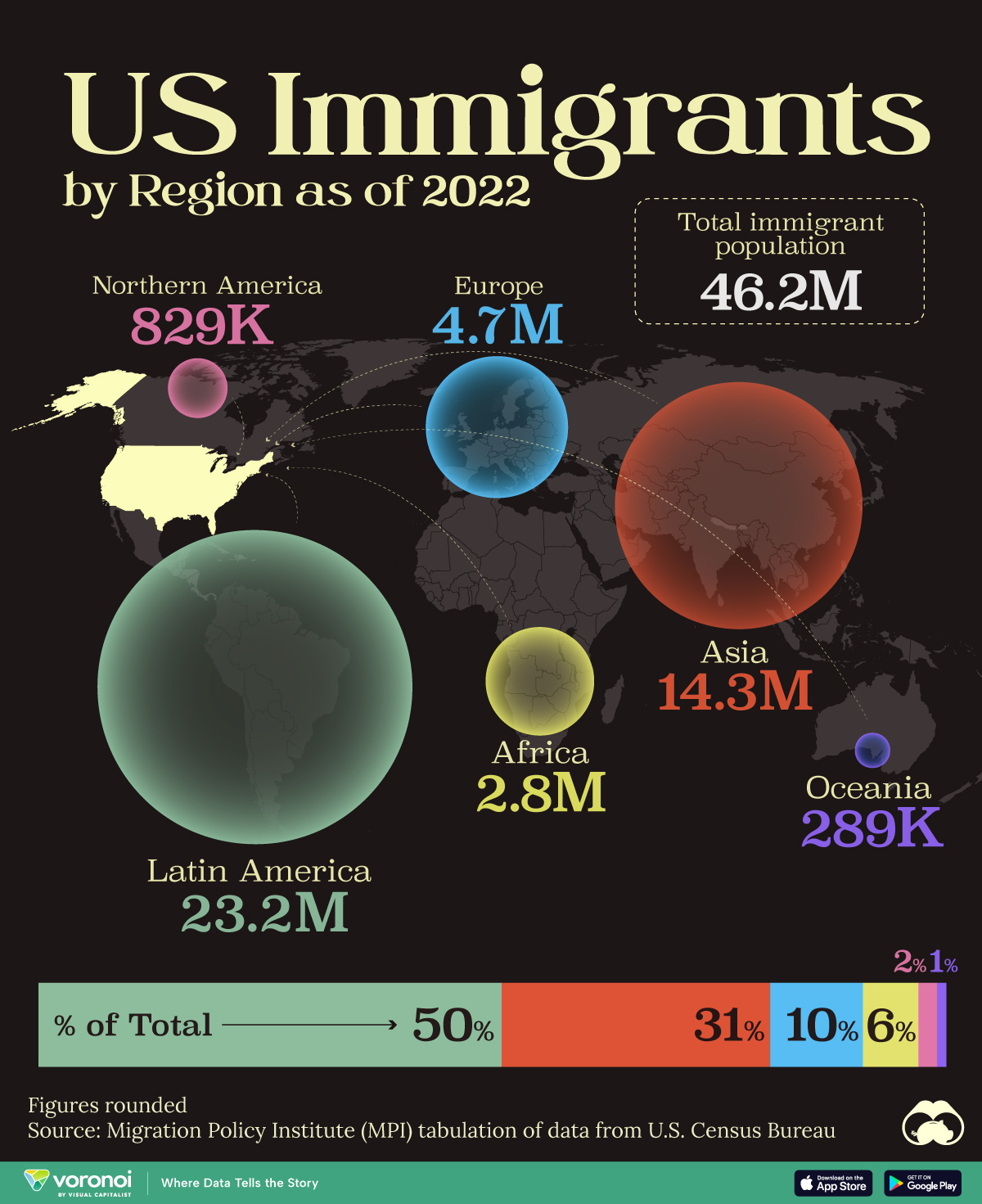Demographics
The World’s 7.5 Billion People, in One Chart
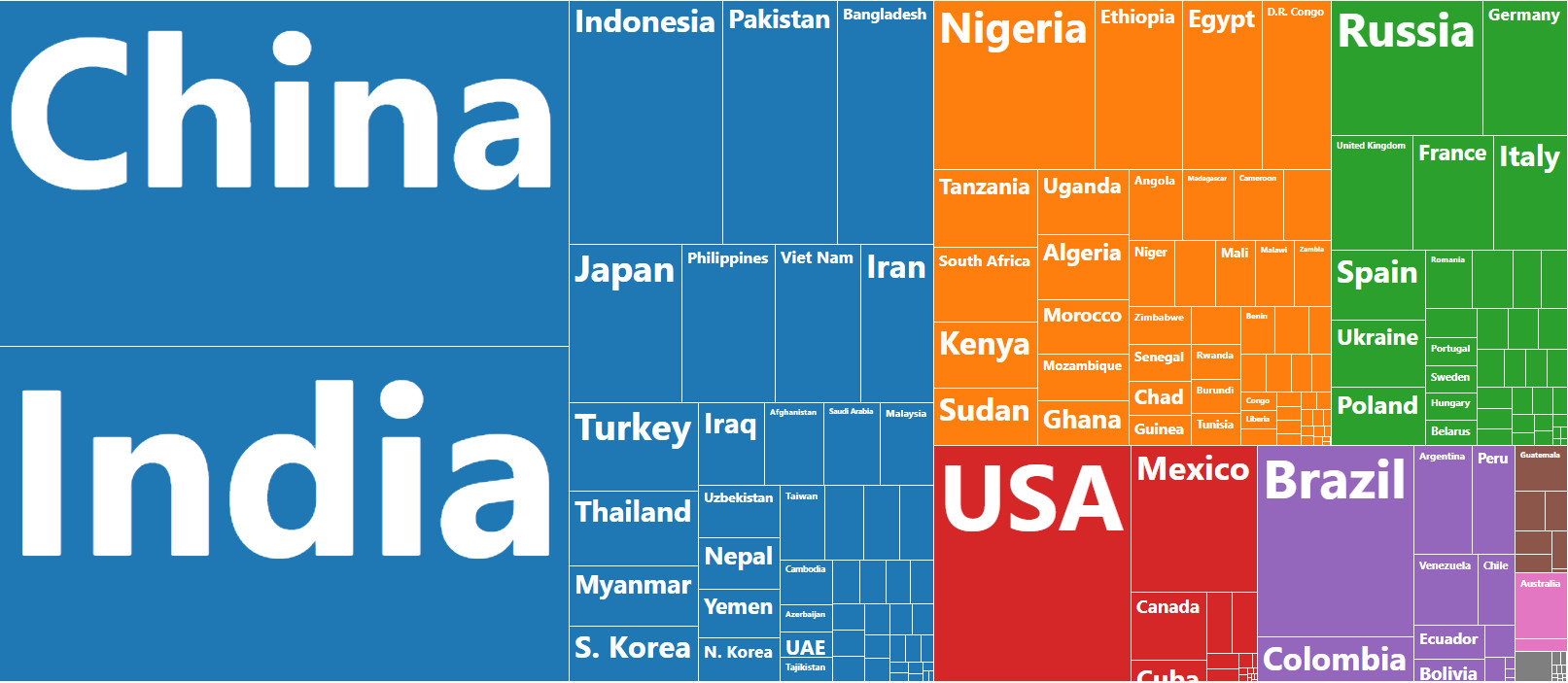
Which countries do people live in, globally?
It’s a very simple question, but it’s also hard to get an accurate sense of the answer by browsing through a lengthy table of country-level population data.
That’s because there are close to 200 countries spread around the globe, with populations ranging from near 1.4 billion (China or India) to countries a mere 0.001% of that size. How is it possible to do the mental math in interpreting such a wide range of data points simultaneously?
Visualizing the World’s Population
Today’s data visualization comes to us from PopulationPyramid.net, a fantastic resource for data on global population numbers.
It allows us to see the location of the world’s 7.5 billion people by resizing countries based on their populations and then coloring and organizing them by region.
This simple application of data visualization makes it more intuitive to comprehend where people live around the globe, as well as how different countries compare in size.
Regional Populations
The first thing you might notice on the graphic is the relative size of regions, with Asia taking up a whopping 60% of the visual space.
Here are those numbers by region broken down further:
| Rank | Region | Share of Global Population (%) | Population |
|---|---|---|---|
| #1 | Asia | 60% | 4.5 billion |
| #2 | Africa | 16% | 1.2 billion |
| #3 | Europe | 10% | 729 million |
| #4 | North America | 7% | 534 million |
| #5 | South America | 6% | 424 million |
| #6 | Central America | 1% | 47 million |
| #7 | Oceania | 1% | 42 million |
When you look at it this way, you can really see how the math breaks down.
About 75% of people reside in Asia or Africa. Meanwhile, the regions of Europe, North America, South America, and Oceania just total together to 25% of the mix.
The 10 Most Populous Countries
There are some countries that are clear standouts on the data visualization.
For example, China and India combine to 2.7 billion people, together accounting for 36% of the total global population.
Those heavyweights aside, there are other notable countries that take up significant amounts of real estate on the visualization as well:
| Rank | Country | Population (2017) | % of global total |
|---|---|---|---|
| #1 | 🇨🇳 China | 1,388,232,693 | 18.5% |
| #2 | 🇮🇳 India | 1,342,512,706 | 17.9% |
| #3 | 🇺🇸 United States | 326,474,013 | 4.3% |
| #4 | 🇮🇩 Indonesia | 263,510,146 | 3.5% |
| #5 | 🇧🇷 Brazil | 211,243,220 | 2.8% |
| #6 | 🇵🇰 Pakistan | 196,744,376 | 2.6% |
| #7 | 🇳🇬 Nigeria | 191,835,936 | 2.6% |
| #8 | 🇧🇩 Bangladesh | 164,827,718 | 2.2% |
| #9 | 🇷🇺 Russia | 143,375,006 | 1.9% |
| #10 | 🇲🇽 Mexico | 130,222,815 | 1.7% |
| Top 10 Total | 4,358,978,629 | 58.0% |
The United States, Indonesia, Brazil, and Pakistan rank between #3 and #6, and have about a billion people between them.
Nigeria, which is #7 on the list, has the world’s fastest growing megacity within its borders. Further, Bangladesh is also a noteworthy entry since it is one of the densest populations globally, with 1,138.9 people per square kilometer of land.
A Final Look at Global Population
This isn’t the first time we’ve shown you a data visualization that organizes the global population – here’s one we previously published that shows each country in a bubble chart:
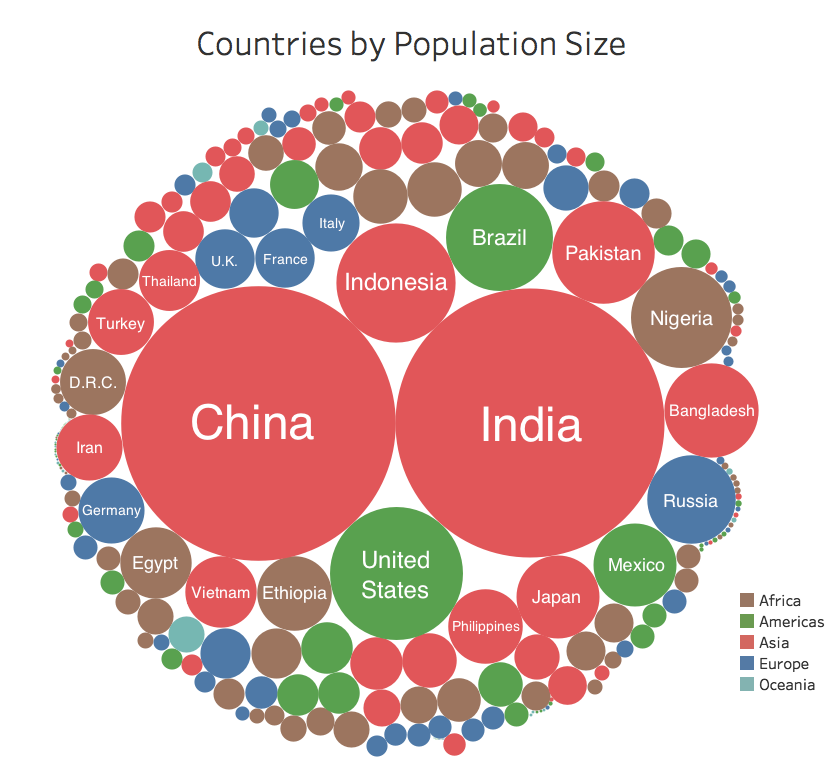
While this uses slightly older data, it is still interesting to see how data visualization can help us understand a complex and wide-ranging set of data that is relevant to everyday life.
Demographics
Mapped: U.S. Immigrants by Region
This map shows which regions U.S. immigrants came from, highlighting Asia and Latin America as the biggest sources.
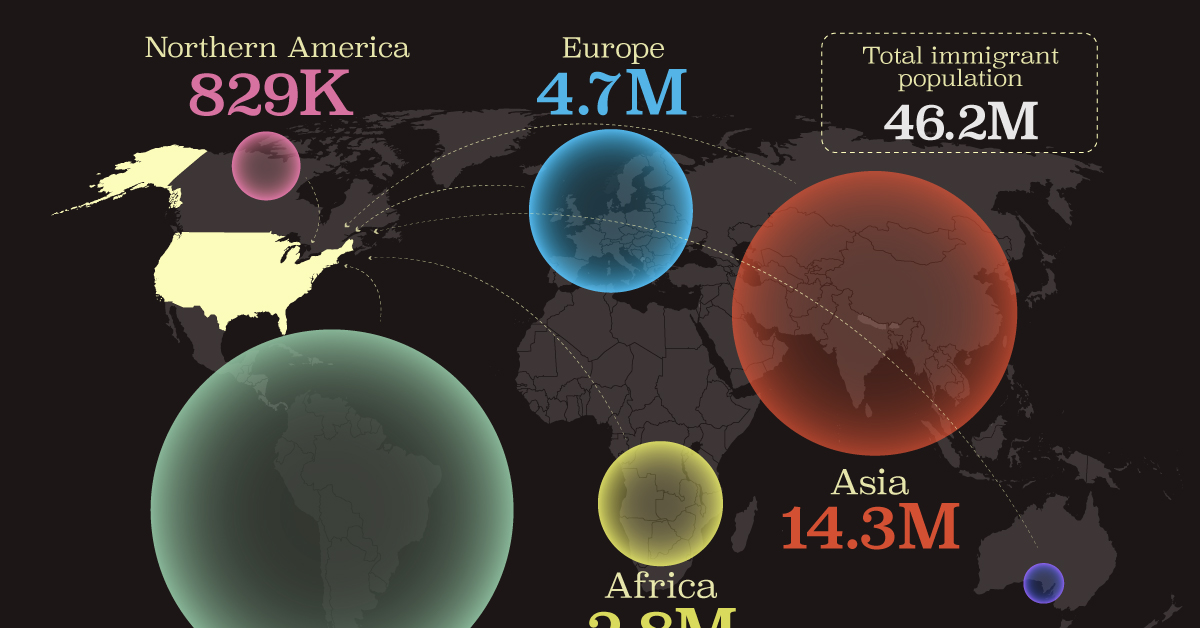
Breaking Down America’s Immigrant Population
This was originally posted on our Voronoi app. Download the app for free on iOS or Android and discover incredible data-driven charts from a variety of trusted sources.
The United States is home to more immigrants than any other nation, surpassing the combined totals of the next four countries: Germany, Saudi Arabia, Russia, and the United Kingdom.
To add context to this impressive fact, we’ve illustrated the regions from which U.S. immigrants originated. “Immigrants” in this context refers to individuals who are residing in the United States but were not U.S. citizens at birth.
These statistics were sourced from the Migration Policy Institute, which analyzed data from the U.S. Census Bureau’s 2022 American Community Survey (ACS).
U.S. Immigrants by Region
From this graphic, we can see that Asia and Latin America emerge as the primary sources of immigration, collectively accounting for 81% of America’s 46.2 million immigrants.
| Region | # of Immigrants | % of Total |
|---|---|---|
| Europe | 4,728,948 | 10 |
| Asia | 14,349,080 | 31 |
| Africa | 2,752,965 | 6 |
| Oceania | 288,560 | 1 |
| Northern America | 828,702 | 2 |
| Latin America | 23,233,834 | 50 |
| Total | 46,182,089 | 100 |
Latin America alone contributes half of the immigrant population. Mexico stands out as the largest contributor to U.S. immigration, with 10.7 million immigrants, attributable to its geographical proximity and historical ties.
Economic factors, including wage disparity and employment opportunities, drive many Mexicans to seek better prospects north of the border.
From Asia, the two largest country sources are China (2.2 million) and India (2.8 million).
Learn More About U.S. Immigration From Visual Capitalist
If you enjoyed this post, be sure to check out Why Do People Immigrate to the U.S.? This visualization shows the different reasons why immigrants chose to come to America in 2021.
-

 Markets5 days ago
Markets5 days agoMapped: The Most Valuable Company in Each Southeast Asian Country
-

 Markets2 weeks ago
Markets2 weeks agoThe Top Private Equity Firms by Country
-

 Jobs2 weeks ago
Jobs2 weeks agoThe Best U.S. Companies to Work for According to LinkedIn
-

 Economy2 weeks ago
Economy2 weeks agoRanked: The Top 20 Countries in Debt to China
-

 Politics1 week ago
Politics1 week agoCharted: Trust in Government Institutions by G7 Countries
-

 Energy1 week ago
Energy1 week agoMapped: The Age of Energy Projects in Interconnection Queues, by State
-

 Mining1 week ago
Mining1 week agoVisualizing Global Gold Production in 2023
-

 Markets1 week ago
Markets1 week agoVisualized: Interest Rate Forecasts for Advanced Economies

